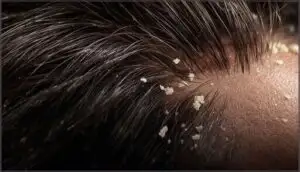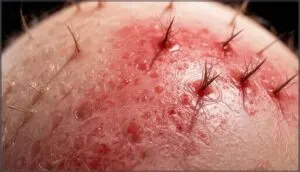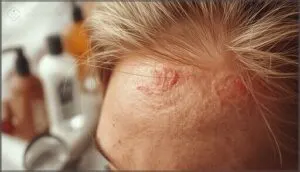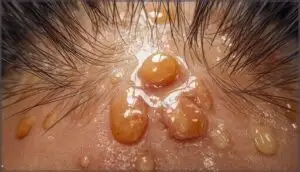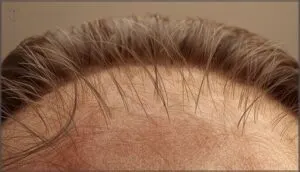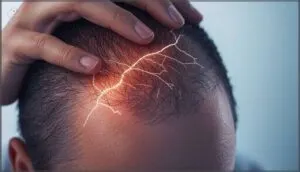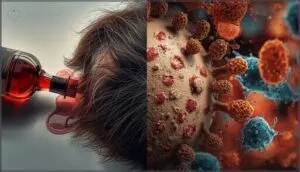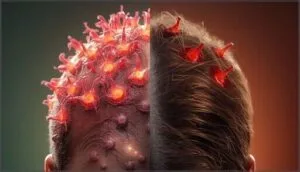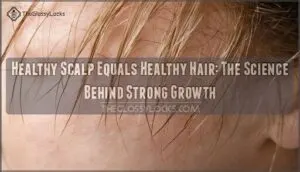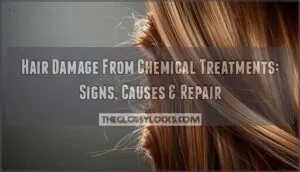This site is supported by our readers. We may earn a commission, at no cost to you, if you purchase through links.
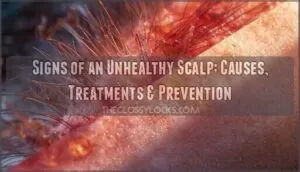 Your scalp might be sending distress signals you’ve been ignoring. That persistent itch, those mysterious flakes on your shoulders, or the sudden increase in hair strands circling your shower drain—these aren’t just cosmetic annoyances. They’re warning signs that something deeper is off balance.
Your scalp might be sending distress signals you’ve been ignoring. That persistent itch, those mysterious flakes on your shoulders, or the sudden increase in hair strands circling your shower drain—these aren’t just cosmetic annoyances. They’re warning signs that something deeper is off balance.
Your scalp is living skin, home to millions of microbes, thousands of nerve endings, and all the follicles responsible for your hair’s health. When inflammation takes hold, follicles shut down, microbial communities shift, and the visible consequences show up fast.
Recognizing the signs of an unhealthy scalp early means you can get to the source before temporary irritation becomes chronic damage, hair loss, or conditions that require professional intervention.
Table Of Contents
Key Takeaways
- Your scalp’s health directly determines your hair’s growth cycle, density, and resilience—inflammation, buildup, or microbial imbalance can shut down follicles, trigger shedding patterns, and cause visible thinning before you realize the damage is occurring.
- Persistent symptoms like flaking, redness, itching, unusual oiliness, or scalp pain aren’t just cosmetic annoyances—they signal underlying conditions such as seborrheic dermatitis, psoriasis, or telogen effluvium that require targeted treatment to prevent chronic hair loss.
- Effective scalp restoration combines consistent cleansing with sulfate-free products, weekly exfoliation to remove buildup, hydrating oils to rebuild the moisture barrier, and stress management to reduce cortisol-driven inflammation that disrupts follicle function.
- If over-the-counter treatments fail within six weeks, or you experience rapid hair loss, spreading inflammation, or scalp tenderness, consult a dermatologist for prescription medications or professional procedures like microneedling or low-level light therapy that deliver measurably better outcomes.
What Are The Signs of an Unhealthy Scalp?
Your scalp can show warning signs long before hair problems become obvious. From persistent flakes to unusual tenderness, these signals tell you something’s off with your scalp’s health.
Let’s walk through the key indicators that deserve your attention.
Flakiness and Dandruff
Why does your scalp sometimes look like it’s staging a snowstorm? Dandruff affects roughly 50% of adults worldwide, creating visible flakes that impact both appearance and quality of life. This common scalp condition ranges from mild to severe presentations:
- Light, scattered white flakes that dust your shoulders
- Yellow, greasy scales that cling stubbornly to hair strands
- Thick, crusty patches concentrated in specific areas
- Fine flaking accompanied by persistent itchiness
Treatment efficacy can reduce severity by up to 88% with consistent care. It’s also worth mentioning that itching scalp is a frequent symptom.
Redness and Inflammation
When your scalp turns pink or red, you’re seeing inflammation in action—cytokine cascades triggering vasodilation beneath the skin. About 9% of scalp conditions present with visible redness, often from seborrheic dermatitis, psoriasis, or scalp rosacea.
Erythema severity can indicate deeper issues like microbial dysbiosis. This condition is often linked to Malassezia yeast.
If inflammation persists, it disrupts blood flow to follicles, potentially shortening your hair’s growth cycle and increasing shedding risk.
Itchiness and Irritation
Persistent itching isn’t just annoying—it signals nerve involvement and often kicks off an itch-scratch cycle that worsens inflammation triggers. Roughly 25% of people report scalp itching, frequently tied to product allergens, scalp microbiome imbalance, or barrier dysfunction.
Key drivers of scalp irritation include:
- Hair care products triggering reactions in up to 30% of users
- Malassezia yeast overgrowth disrupting your scalp microbiome
- Increased transepidermal water loss from barrier breakdown
- Stress amplifying itchy scalp intensity
- Contact dermatitis from cosmetic ingredients
Chronic scalp itching can disrupt sleep and greatly impact your quality of life.
Excessive Oiliness
When your hair looks greasy hours after washing, you’re seeing sebum overproduction in action—affecting roughly 6% of adults, with men more prone than women. This excessive oil creates follicle clogging, disrupts your scalp’s microbial balance, and often stems from hormonal influence or stress.
Left unchecked, scalp oiliness concerns raise your seborrheic risk and can trigger inflammation that compromises healthy growth.
Unusual Hair Shedding or Thinning
When you’re losing more than 100 strands daily, you’re likely experiencing telogen effluvium—a shift that often follows stress, illness, or hormonal changes by two to three months. This hair shedding disrupts follicle health and can evolve into noticeable thinning patterns at your temples and crown, signaling deeper scalp concerns.
- Shedding causes include hormonal imbalances, stress, and nutrient deficiencies
- Alopecia types range from telogen effluvium to androgenetic pattern loss
- Hair density declines 6–12% per decade after age 30
Scalp Sensitivity or Pain
When your scalp burns, aches, or feels sore to the touch—even when there’s no visible damage—you’re experiencing trichodynia, a condition affecting up to 32% of hair loss patients. This scalp pain stems from neuropathic mechanisms involving substance P and neurogenic inflammation, often worsened by stress correlation that amplifies nerve sensitivity.
Scalp pain without visible damage—called trichodynia—affects nearly a third of hair loss patients through nerve inflammation amplified by stress
Diagnostic tools like quantitative sensory testing reveal underlying scalp tenderness, while microbiome impact studies show altered bacterial communities in sensitive scalps. Clinical management may include low-dose antidepressants or anti-inflammatory topicals targeting these scalp symptoms.
| Symptom Type | Prevalence | Primary Trigger |
|---|---|---|
| Burning sensation | 33% of cases | Nerve hypersensitivity |
| Pain or aching | 39% of cases | Neurogenic inflammation |
| Itching | 27% of cases | Microbiome disruption |
| Pricking | 23% of cases | C-fiber activation |
Common Causes of Scalp Problems
Understanding what’s causing your scalp issues is the first step toward fixing them. Several factors can throw your scalp’s natural balance off track, from the products you use daily to underlying skin conditions you mightn’t realize you have.
Let’s look at the most common culprits behind scalp problems and what makes them so disruptive to your scalp’s health.
Hair Product Buildup
You probably don’t realize how much residue your styling products leave behind. Silicones, mineral oils, and petroleum-based ingredients create stubborn layers on your scalp that resist rinsing.
This hair product buildup clogs follicles, blocks oxygen flow, and can slow hair growth.
Clarifying shampoos help with scalp buildup removal, but preventing product buildup starts with choosing lighter hair care product ingredients and washing more consistently.
Skin Conditions (e.g., Dermatitis, Psoriasis)
When skin conditions take hold, your scalp becomes a battleground. Seborrheic dermatitis affects around 10 million Americans each year, causing oily, red patches and persistent flakes. Scalp psoriasis impacts 2–3% of people worldwide with silvery scales and inflammation that can trigger temporary hair loss.
These dermatological conditions stem from immune responses, yeast imbalances, and genetic factors—understanding condition prevalence and dermatitis triggers helps you recognize what’s actually happening beneath those symptoms.
Poor Scalp Hygiene
Skipping washes might seem harmless, but your scalp pays the price. Extended intervals between washes allow sebum accumulation and microbial imbalance—Malassezia yeast populations can surge up to 1,000-fold, causing follicle occlusion and scalp odor. Product residue traps dead cells, blocking oxygen delivery to follicles and worsening hair buildup.
Regular scalp care protects your scalp health:
- Wash every 1–4 days based on your oiliness
- Remove hair product buildup with gentle cleansers
- Adjust hair washing frequency when you notice increased flaking or itchiness
Environmental and Lifestyle Factors
Your surroundings shape your scalp more than you might think. Air pollution drives up inflammation, while hard water quality deposits minerals that trigger irritation in 36% of cases. UV radiation damages follicles, stress levels spike cortisol by 12%, and poor diet fuels chronic conditions.
Environmental factors like heat styling and chemical exposure compound the damage, making protective measures essential.
How Unhealthy Scalp Affects Hair Health
Your scalp isn’t just the foundation for your hair—it’s an active ecosystem that directly influences what grows from it. When that environment becomes compromised by inflammation, buildup, or imbalance, your hair pays the price in visible ways.
Let’s look at how an unhealthy scalp shows up in the strands themselves.
Hair Loss and Shedding Patterns
How can you tell when your shedding crosses the line from normal to problematic? Losing 50–100 hairs daily is typical, but if you’re consistently exceeding that, it may signal telogen effluvium or pattern baldness. Multiple hair loss causes—stress, seasonal shedding, hormonal shifts—can alter shedding frequency and disrupt hair follicles, accelerating hair thinning.
- Shedding triggers include childbirth, fever, or dietary deficiencies
- Telogen effluvium can cause loss of up to 50% of scalp hair
- Seasonal shedding peaks occur in late summer and spring
- Pattern baldness affects 85% of men and 33% of women eventually
Poor Hair Elasticity and Breakage
When your hair snaps instead of stretches, you’re looking at compromised protein integrity and moisture retention—both direct signs of an unhealthy scalp. Poor hair elasticity means strands can’t flex without breaking, often traced to cuticle damage from product buildup, UV exposure, or inflammation.
Clinical diagnosis relies on these breakage patterns to assess overall hair and scalp health, guiding treatment before thinning becomes irreversible.
Split Ends and Frizz
Split ends and frizzy hair signal deeper mechanical damage and moisture imbalance at the scalp level. When hair structure weakens from chemical treatments or environmental stress, the protective cuticle lifts—triggering frizz under high humidity and longitudinal cracks that become split ends.
Hair texture deteriorates as strands lose their lipid barrier.
Preventative care includes silicone-based conditioners, regular trims every six to eight weeks, and coconut oil pre-wash treatments to seal moisture and reduce protein loss.
Dull or Lifeless Hair
Beyond breakage and frayed ends, an unhealthy scalp robs your hair of its natural glow. Oxidative stress, sebum imbalance, and nutritional deficiencies combine with environmental damage and product damage to strip protective lipids, leaving strands dull and lifeless—key signs of unhealthy hair. Studies show ROS can increase by 45% in damaged follicles.
Restoring hair shine requires:
- Antioxidant-rich scalp treatments to combat oxidative stress
- Balanced cleansing to regulate sebum production
- Nutrient-dense diets addressing deficiencies in iron, zinc, and vitamin D
Effective Treatments for Scalp Issues
Treating scalp issues effectively means addressing the root cause, whether it’s inflammation, buildup, or dryness. The right approach depends on your specific condition, but most treatments work by restoring balance, removing irritants, and supporting the skin’s natural barrier.
Here are the most effective treatment options available.
Medicated Shampoos and Topicals
When your scalp condition doesn’t respond to over-the-counter care, medicated shampoos and topicals become essential. Ketoconazole efficacy reaches 88% clearance rates for seborrheic dermatitis within weeks, while selenium sulfide combined with salicylic acid combats stubborn dandruff.
Topical corticosteroids calm inflammation from psoriasis or eczema, and combination therapies offer faster relief. For hair thinning, minoxidil benefits include improved density and reduced shedding.
A dermatologist can guide your scalp treatment plan.
Scalp Exfoliation and Scrubs
One of the most underrated exfoliation benefits is how it clears away the buildup that suffocates your follicles. Weekly scalp exfoliation with a gentle scalp scrub can remove 30% more residue than shampooing alone.
Physical and chemical exfoliation methods both work, though combination formulas show 40% better results. This scalp care step boosts microbial balance and strengthens hair from the root.
Hydrating Oils and Masks
After exfoliation, hydrating oils and masks rebuild your scalp’s moisture barrier. Coconut oil boosts hydration by 76% in just two weeks, while argan and almond oils improve elasticity up to 34%. These hydration regimens target dryness, flakes, and itching at the source.
Application methods matter—warm the oil slightly, massage into your scalp for five minutes, then leave on for 20-30 minutes before washing. DIY recipes combining sesame and castor oils showed 48% better microbial balance in studies.
Top oil benefits and mask ingredients:
- Coconut oil restores barrier function and reduces water loss
- Argan oil balances sebum and protects against UV damage
- Almond oil strengthens hair cuticles and retains moisture
- Botanical hair masks improve manageability without buildup
- Essential oils rich in linoleic acid accelerate lipid repair
Gentle, Sulfate-Free Cleansers
Switching to sulfate-free shampoo protects your scalp’s natural lipid barrier—that’s why over 65% of users report improved moisture retention and reduced dryness. These gentle cleansers use plant-based surfactants like cocobetaine instead of harsh sulfates, cutting irritation by 40% in sensitive scalps.
| Benefit | Traditional Sulfates | Sulfate-Free Formulas |
|---|---|---|
| Scalp irritation reports | 38% of users | Under 10% of users |
| Moisture retention | Moderate stripping | 65%+ improvement |
| Recommended for sensitivity | Not ideal | Dermatologist-approved |
Modern formulation trends now incorporate shea butter and coconut oil, delivering effective scalp care without compromising your skin’s defenses. Consumer preferences have shifted dramatically—60% choose sulfate-free options specifically to address allergic reactions and chronic conditions like dermatitis. The regulatory landscape reinforces this, with 49% of 2024 launches earning eco-certifications.
Your hair care routine benefits immediately: less frizz, stronger strands, and a balanced scalp microbiome that prevents buildup and inflammation.
Professional Scalp Treatments
Microneedling with minoxidil delivered a 91.4 hair count increase at 12 weeks—four times better than minoxidil alone—while low-level light therapy boosted density by 37% in controlled trials.
Your dermatologist or trichologist can recommend scalp spas, serums, or sophisticated procedures based on your specific condition.
With the professional scalp treatment market reaching $9.36 billion and patient satisfaction exceeding 95%, these dermatologist consultation-backed options genuinely transform scalp health.
Preventing and Restoring Scalp Health
A healthy scalp doesn’t happen by accident—it requires consistent care and attention to what you put on and in your body.
Prevention isn’t complicated, but it does mean being intentional about your daily habits and diet, and knowing when professional help might be necessary.
Here’s what you need to focus on to keep your scalp in prime condition.
Consistent Wash and Care Routine
Your hair care routine forms the foundation of scalp health, so don’t overlook washing frequency and product ingredients. Aim to wash 1-4 times weekly based on your scalp type, using sulfate-free cleansers that preserve natural oils.
Master proper washing techniques with lukewarm water and gentle massage, then follow with controlled drying methods.
Incorporate clarifying shampoos weekly to remove buildup without over-stripping.
Dietary and Hydration Tips
What you eat and drink directly impacts your scalp’s condition. Nutritional deficiencies in vitamins A, C, D, and zinc can trigger inflammation and excessive oiliness, while dehydration weakens your scalp’s moisture barrier.
Focus on antioxidant-rich fruits, lean proteins, and omega-3 fatty acids to support follicle health. Limit processed foods and sugar, which worsen seborrheic dermatitis.
Drink at least 2-3 liters of water daily—proper hydration reduces flakiness and strengthens your scalp’s natural defenses against irritation.
Stress Management for Scalp Health
Chronic stress floods your scalp with cortisol and inflammatory markers, choking blood flow to follicles and triggering conditions like telogen effluvium. Managing stress levels protects your scalp health directly:
- Daily mindfulness practices lower stress hormones within weeks
- Scalp massage boosts circulation while reducing cortisol
- Regular exercise and sleep support overall wellness and hair retention
Stress and hair loss are physiologically linked—address both simultaneously.
When to Consult a Dermatologist
While stress management helps, persistent symptoms lasting over a month warrant dermatologist consultation. If OTC treatments fail within six weeks, or you notice rapid hair loss, scalp pain, or spreading inflammation, professional evaluation is essential.
Most scalp conditions—from stubborn seborrheic dermatitis to autoimmune hair loss—respond best to prescription medications and specialized procedures that only dermatologists can provide.
Frequently Asked Questions (FAQs)
Can scalp health affect hair color or texture?
Yes—your scalp’s condition directly influences hair quality. Oxidative stress, nutrient absorption issues, and scalp microbiome imbalances can trigger texture irregularities, color changes, and compromised hair and scalp health over time.
Is an unhealthy scalp contagious to others?
Most scalp problems like dandruff, dermatitis, and psoriasis aren’t contagious. However, contagious scalp conditions—tinea capitis, head lice, and scabies—spread through direct contact. Understanding transmission prevention protects others from these specific infections.
Do seasonal changes worsen scalp conditions?
Climate shifts can really throw your scalp off balance. Winter scalp dryness strips moisture, while summer oil buildup clogs follicles.
Allergy-related itch, UV radiation effects, and seasonal microbiome shifts all contribute to scalp irritation and worsen existing scalp conditions.
Can medications cause sudden scalp problems?
Certain medications can trigger sudden scalp changes, causing telogen effluvium, anagen effluvium, drug-induced folliculitis, or xerosis. Some drugs even lead to permanent alopecia.
If you notice scalp irritation or thinning, consult your dermatologist promptly.
Does hair dye damage an already unhealthy scalp?
When you already have inflammation or dermatitis, chemical exposure from hair dye triggers barrier disruption and condition exacerbation.
Ammonia and PPD worsen scalp irritation causes, amplifying chemical sensitivities while accelerating long-term risks and hair damage.
Conclusion
Think of your scalp as the soil where your hair takes root. When the foundation crumbles, nothing above it can truly thrive. Recognizing the signs of an unhealthy scalp early gives you the power to intervene before minor irritation becomes lasting damage.
Whether it’s adjusting your routine, choosing better products, or consulting a dermatologist, you’re not just treating symptoms—you’re restoring the ecosystem your hair depends on. Your scalp’s health is your hair’s future.
- https://pmc.ncbi.nlm.nih.gov/articles/PMC4852869/
- https://academic.oup.com/bjd/article/193/Supplement_2/ii32/8294184
- https://firstimpressionsclinic.ca/2022/11/07/healthy-scalp-vs-unhealthy-scalp-how-to-tell-the-difference/
- https://karger.com/sad/article/9/6/407/862911/Sensitive-Scalp-and-Trichodynia-Epidemiology
- https://my.clevelandclinic.org/health/diseases/12423-alopecia-areata

